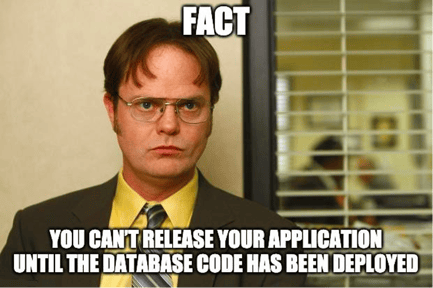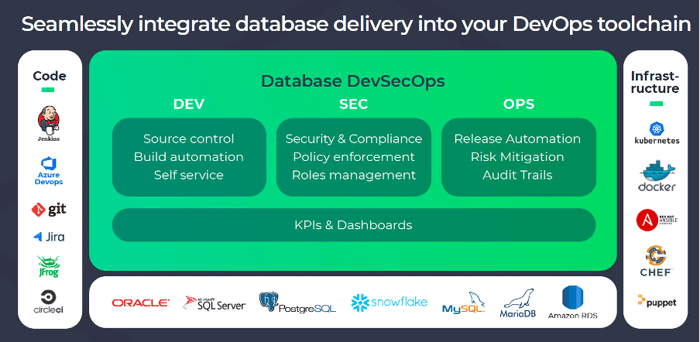In today's fast-paced business environment, organizations are under constant pressure to deliver new features and updates to their customers as quickly as possible. One way to achieve this is by adopting DevOps principles and practices, which focus on automating and streamlining the development, testing, and deployment of software.
But what about the database? While DevOps has traditionally focused on application code, it is increasingly being applied to database systems as well. This is known as "database DevOps."
Database DevOps refers to the practice of applying DevOps principles and practices to database systems. This includes the development, testing, deployment, and maintenance of databases and their associated infrastructure. The goal of database DevOps is to improve the speed, reliability, and security of database systems by automating and streamlining the various processes involved in managing them. This can involve using tools such as version control systems, continuous integration and delivery pipelines, and infrastructure as code to manage database deployments and updates.

Challenges
There are several challenges that database administrators (DBAs) may face when managing database operations:
- Complexity: Modern database systems can be complex, with many different components and dependencies. This can make it difficult to understand how everything fits together and to troubleshoot issues when they arise.
- Version control: It can be difficult to keep track of changes made to a database over time, especially in large organizations with many different teams and individuals working on the database.
- Deployment and testing: Deploying and testing database changes can be time-consuming and error-prone, especially when done manually.
- Performance: Ensuring that a database is performing optimally can be a challenge, as it requires monitoring various metrics and identifying and addressing performance issues.
- Security: Keeping a database secure requires staying up to date with the latest threats and vulnerabilities and implementing appropriate security measures.
- Scalability: As the volume of data and the number of users accessing a database grow, it can be difficult to scale the database to meet the increased demand.
Benefits
There are several benefits to implementing database DevOps:
- Improved reliability: By automating the deployment and testing of database changes, you can reduce the risk of errors and improve the reliability of your database systems.
- Increased efficiency: Automating database management tasks can save time and reduce the effort required to maintain your databases.
- Faster deployment: By streamlining the process of deploying and updating databases, you can reduce the time it takes to get new features or fixes into production.
- Enhanced security: Automating database management can help ensure that security best practices are followed consistently, improving the overall security of your database systems.
- Improved collaboration: By using version control and other collaborative tools, database DevOps can facilitate better collaboration between different teams and individuals working on a database project.
So there is a need for a proper Database Release Management!
What is Database Release Management?
Database release management refers to the process of managing the deployment of changes to a database. This can include both code changes (such as schema updates or stored procedure modifications) and data changes (such as importing new data or making updates to existing data).
Database release management typically involves the following steps:
- Planning: Identifying the changes that need to be made to the database and creating a plan for implementing them.
- Development: Making the necessary changes to the database, which may involve writing SQL scripts or other code.
- Testing: Testing the changes to ensure that they work as intended and do not break any existing functionality.
- Deployment: Deploying the changes to the production database. This may involve applying the changes directly to the database or using a database migration tool to automate the process.
- Rollback: Having a plan in place to roll back the changes if necessary, in case something goes wrong during the deployment process.
The goal of database release management is to ensure that changes to the database are made in a controlled, reliable, and efficient manner.
Risks of Manual Database Releases
There are several risks associated with performing manual database releases:
- Human error: Manual releases are prone to errors caused by human oversight or mistakes. For example, a DBA may accidentally run the wrong script or make a typo in a SQL statement.
- Lack of consistency: Without a standardized process in place, each manual release may be different, making it difficult to ensure that all releases are completed in the same way.
- Longer lead times: Manual releases can be time-consuming, as they require someone to manually execute each step in the process. This can lead to longer lead times for getting changes into production.
- Difficulty tracking changes: It can be difficult to track and document the changes made during a manual release, which can make it harder to understand what has been done and why.
- Risk of data loss: If something goes wrong during a manual release, there is a risk of data loss or corruption. This can be especially problematic if the release involves making updates to live data.
Meet DBmaestro!
To overcome the bottleneck that we mentioned earlier, there is a number of solutions out there where it leads our way to DBmaestro.

DBmaestro is a self-service tool for DevOps teams to automate, secure, and govern Database CI/CD pipelines. It accelerates your release pipeline by ensuring successful, seamless and audited high-quality releases every single time.
In addition to DevOps best practices, DBmaestro also automates database security, compliance, and governance by enforcing organizational policies, managing roles and permissions, and fulfilling compliance regulations, all while creating a fully detailed audit trail of all activities.

DBmaestro supports database pipelines for:
- Oracle
- MSSQL
- MySQL
- PostgreSQL
- MongoDB
- SnowFlake
- MariaDB
If you are interested and want to learn more about how it can help you automate your database releases, check here!
What are your challenges with database release management?
